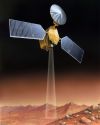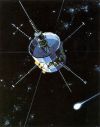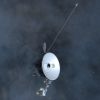Emily Lakdawalla • Jun 01, 2010
What's up in the solar system in June 2010
The greatest drama in June 2010 will come from two Japanese missions. If all goes well, Hayabusa will plunge to a fiery death in Earth's atmosphere on June 13, sacrificing himself in order to return a small container that probably doesn't, but just might, contain some dust from asteroid Itokawa. Regardless of what's found inside the container, its return will close one of the most gripping sagas in interplanetary exploration. The other Japanese mission to watch is IKAROS, which is now unfolding its solar sail, a process that should, if successful, be complete before the month is out. This month will also see an Earth flyby by Deep Impact, and encounters with Pandora, Rhea, and Titan by Cassini, which is completing its first mission extension June 30. On to the detailed overview:
In the inner solar system:
 The MESSENGER spacecraft is cruising along, with less than a year remaining until Mercury orbit insertion (which is planned for March 18, 2011). The mission has been posting cool images of newly named craters as they continue to work on their global map of Mercury in preparation for their orbital mission. My favorite of the last month is this one of Hokusai, the crater responsible for the huge ray system that covers an entire hemisphere of Mercury.
The MESSENGER spacecraft is cruising along, with less than a year remaining until Mercury orbit insertion (which is planned for March 18, 2011). The mission has been posting cool images of newly named craters as they continue to work on their global map of Mercury in preparation for their orbital mission. My favorite of the last month is this one of Hokusai, the crater responsible for the huge ray system that covers an entire hemisphere of Mercury.
 Venus Express has been quiet recently but is presumably still observing the planet's clouds. It now looks quite likely that there will be two active spacecraft at Venus by December. A glance at the ever-useful visual graph of active planetary probes informs me that the last time that was true was in mid-1992, when Pioneer Venus and Magellan were both in orbit.
Venus Express has been quiet recently but is presumably still observing the planet's clouds. It now looks quite likely that there will be two active spacecraft at Venus by December. A glance at the ever-useful visual graph of active planetary probes informs me that the last time that was true was in mid-1992, when Pioneer Venus and Magellan were both in orbit.
 JAXA's Akatsuki is, of course, the spacecraft en route to join Venus Express at the second planet. It is now cruising and in good shape, scheduled for Venus arrival in "late December."
JAXA's Akatsuki is, of course, the spacecraft en route to join Venus Express at the second planet. It is now cruising and in good shape, scheduled for Venus arrival in "late December."
 JAXA's IKAROS, too, is flying toward Venus, but not planned to stop there. This month should see the first-of-its-kind attempted deployment of the thin-film solar sail. I'll be covering every step of that process in the blog!
JAXA's IKAROS, too, is flying toward Venus, but not planned to stop there. This month should see the first-of-its-kind attempted deployment of the thin-film solar sail. I'll be covering every step of that process in the blog!
The third spacecraft that launched toward Venus with Akatsuki and IKAROS, the first university-built deep-space craft named Shin-en or UNITEC-1, has, unfortunately, been lost.
 Lunar Reconnaissance Orbiter is busily mapping the Moon from its science orbit. They continue to release spectacular photos like this gorgeous one of a fresh impact crater and this neat one of a boulder track that terminates with the boulder sitting neatly inside the pocket of a crater. There are lots more captioned LROC images available, and the laser altimeter team is releasing image every week. This month, on June 15, will see the second enormous pile of LRO data released to the view of lunar scientists and armchair astronauts alike via the Planetary Data System; the release will include all science data acquired between December 16, 2009 and March 15, 2010.
Lunar Reconnaissance Orbiter is busily mapping the Moon from its science orbit. They continue to release spectacular photos like this gorgeous one of a fresh impact crater and this neat one of a boulder track that terminates with the boulder sitting neatly inside the pocket of a crater. There are lots more captioned LROC images available, and the laser altimeter team is releasing image every week. This month, on June 15, will see the second enormous pile of LRO data released to the view of lunar scientists and armchair astronauts alike via the Planetary Data System; the release will include all science data acquired between December 16, 2009 and March 15, 2010.
 JAXA's Hayabusa is now only about 5 million kilometers from Earth, closing at the rate of roughly one lunar distance per day; this month will hopefully see the fiery death of the spacecraft and the successful landing of its sample return capsule. What a spectacular story this mission has been, no matter how it ends! The capsule should arrive in the Woomera desert, Australia, on June 13 at about 14:00 UTC. Hayabusa recently completed the third of five planned trajectory correction maneuvers that are needed to aim the sample return capsule at the desired entry point. If you want to start conversations with people about this mission, why not buy our cool Hayabusa Return T-shirt?
JAXA's Hayabusa is now only about 5 million kilometers from Earth, closing at the rate of roughly one lunar distance per day; this month will hopefully see the fiery death of the spacecraft and the successful landing of its sample return capsule. What a spectacular story this mission has been, no matter how it ends! The capsule should arrive in the Woomera desert, Australia, on June 13 at about 14:00 UTC. Hayabusa recently completed the third of five planned trajectory correction maneuvers that are needed to aim the sample return capsule at the desired entry point. If you want to start conversations with people about this mission, why not buy our cool Hayabusa Return T-shirt?
 Hayabusa is not the only small body mission to be approaching Earth this month. NASA's Deep Impact is cruising toward its November 4 flyby of comet 103P/Hartley 2; on June 27, it'll perform a swingby of Earth to line it up for that encounter.
Hayabusa is not the only small body mission to be approaching Earth this month. NASA's Deep Impact is cruising toward its November 4 flyby of comet 103P/Hartley 2; on June 27, it'll perform a swingby of Earth to line it up for that encounter.
On to Mars:
 Out at Mars, winter has arrived to the southern latitudes (it's currentlyLs 98.7°), which means that the rovers have passed through their darkest nights of the year. Today it is Mars Exploration Rover Spirit sol 2279 and Opportunity sol 2259. Spirit has still not been heard from since sol 2210 (March 22). The orbiters continue to listen for signals from Spirit during scheduled passes, and the Deep Space Network also listens every day. As I guessed a few days ago, and as Steve Squyres confirmed in the latest monthly rover update from A. J. S. Rayl, Opportunity has finally made the eastward turn on her long trek toward Endeavour crater. (Recent drives have still all aimed her south of due east, but they add up to an eastward trend.) Here is Eduardo Tesheiner's latest route map and Google Earth kml file for Opportunity.
Out at Mars, winter has arrived to the southern latitudes (it's currentlyLs 98.7°), which means that the rovers have passed through their darkest nights of the year. Today it is Mars Exploration Rover Spirit sol 2279 and Opportunity sol 2259. Spirit has still not been heard from since sol 2210 (March 22). The orbiters continue to listen for signals from Spirit during scheduled passes, and the Deep Space Network also listens every day. As I guessed a few days ago, and as Steve Squyres confirmed in the latest monthly rover update from A. J. S. Rayl, Opportunity has finally made the eastward turn on her long trek toward Endeavour crater. (Recent drives have still all aimed her south of due east, but they add up to an eastward trend.) Here is Eduardo Tesheiner's latest route map and Google Earth kml file for Opportunity.
 ESA's Mars Express mission remains pretty quiet, but we know the spacecraft is still doing great because nearly every day, new images from the Mars Webcam show up. Via Twitter the VMC team announced that we should be looking for a set of images that documents a complete, elliptical orbit by Mars Express -- I can't wait for that!
ESA's Mars Express mission remains pretty quiet, but we know the spacecraft is still doing great because nearly every day, new images from the Mars Webcam show up. Via Twitter the VMC team announced that we should be looking for a set of images that documents a complete, elliptical orbit by Mars Express -- I can't wait for that!
 Mars Reconnaissance Orbiter is humming along in normal science operations. The latest MARCI weather report states that with the arrival of summer to the north pole, the seasonal carbon dioxide polar cap has completely dissipated; and sublimation of the residual water ice cap is enriching the atmosphere in water, making more ice cloud formation. The latest captioned image releases from HiRISE include this view of a possible field of volcanic cones in Phlegra Dorsa, and this dramatic view following up on some gullies spotted in earlier images taken by MOC on Mars Global Surveyor.
Mars Reconnaissance Orbiter is humming along in normal science operations. The latest MARCI weather report states that with the arrival of summer to the north pole, the seasonal carbon dioxide polar cap has completely dissipated; and sublimation of the residual water ice cap is enriching the atmosphere in water, making more ice cloud formation. The latest captioned image releases from HiRISE include this view of a possible field of volcanic cones in Phlegra Dorsa, and this dramatic view following up on some gullies spotted in earlier images taken by MOC on Mars Global Surveyor.
 NASA's Mars Odyssey remains the longest-lived spacecraft in orbit at Mars. You can see the latest from its THEMIS instrument here. I like this one showing a bit of the curvaceous Nanedi Valles.
NASA's Mars Odyssey remains the longest-lived spacecraft in orbit at Mars. You can see the latest from its THEMIS instrument here. I like this one showing a bit of the curvaceous Nanedi Valles.
In the Asteroid Belt:
 ESA's Rosetta mission is rapidly approaching its July 10 encounter with the asteroid 21 Lutetia. Closest approach will be at 15:44:53 UTC. ESA has reactivated the Rosetta Blog, which is what I'll be watching for news and updates on the status of the mission. According to the most recent status report, the spacecraft is healthy and has completed the pre-encounter check-outs. The report mentions that Rosetta will be breaking a significant record in July, just after encountering Lutetia: it will become the record holder for solar-powered spacecraft flying most distant from the Sun once it surpasses Stardust's record of 2.72 AU. The Lutetia flyby is Rosetta's last planned scientific event before its May 2014 rendezvous with comet Churyumov-Gerasimenko; it will spend much of the remaining cruise period, beginning June 2011, in a state of deep hibernation.
ESA's Rosetta mission is rapidly approaching its July 10 encounter with the asteroid 21 Lutetia. Closest approach will be at 15:44:53 UTC. ESA has reactivated the Rosetta Blog, which is what I'll be watching for news and updates on the status of the mission. According to the most recent status report, the spacecraft is healthy and has completed the pre-encounter check-outs. The report mentions that Rosetta will be breaking a significant record in July, just after encountering Lutetia: it will become the record holder for solar-powered spacecraft flying most distant from the Sun once it surpasses Stardust's record of 2.72 AU. The Lutetia flyby is Rosetta's last planned scientific event before its May 2014 rendezvous with comet Churyumov-Gerasimenko; it will spend much of the remaining cruise period, beginning June 2011, in a state of deep hibernation.
Exploring Saturn:
 NASA's Cassini is now entering the very last month of its first mission extension; the so-called Extended-Extended mission or XXM starts on July 1. Cassini recently popped into a slightly inclined orbit around Saturn, which permits it to return to some ring science; there will be repeated lengthy scans of the ring system early this month, as well as nontargeted encounters with several of the moons. As outlined in the Rev 132 "Looking Ahead" article, June 3 will be especially busy, with imaging of Pandora's southern leading hemisphere, a nearly complete longitudinal scan of the A ring to search for "propellers," and a good view of Rhea from under 70,000 kilometers away. There are two targeted Titan encounters this month, on June 5 and 21. The month begins on Cassini's rev 132 and ends toward the end of rev 134.
NASA's Cassini is now entering the very last month of its first mission extension; the so-called Extended-Extended mission or XXM starts on July 1. Cassini recently popped into a slightly inclined orbit around Saturn, which permits it to return to some ring science; there will be repeated lengthy scans of the ring system early this month, as well as nontargeted encounters with several of the moons. As outlined in the Rev 132 "Looking Ahead" article, June 3 will be especially busy, with imaging of Pandora's southern leading hemisphere, a nearly complete longitudinal scan of the A ring to search for "propellers," and a good view of Rhea from under 70,000 kilometers away. There are two targeted Titan encounters this month, on June 5 and 21. The month begins on Cassini's rev 132 and ends toward the end of rev 134.
Quietly cruising:
 The International Cometary Explorer remains on course for a return visit to Earth in 2014. When it does, ICE can be returned to a Sun-Earth L1 halo orbit, or can use multiple Earth swingbys to encounter Comet Wirtanen during its near-Earth apparition in December 2018.
The International Cometary Explorer remains on course for a return visit to Earth in 2014. When it does, ICE can be returned to a Sun-Earth L1 halo orbit, or can use multiple Earth swingbys to encounter Comet Wirtanen during its near-Earth apparition in December 2018.
![]() NASA's Dawn is now in the asteroid belt for good, and is steadily thrusting with its ion engines, patiently propelling itself toward a rendezvous with Vesta in July 2011. I just posted Marc Rayman's latest Dawn Journal, which describes the plans for science at Vesta.
NASA's Dawn is now in the asteroid belt for good, and is steadily thrusting with its ion engines, patiently propelling itself toward a rendezvous with Vesta in July 2011. I just posted Marc Rayman's latest Dawn Journal, which describes the plans for science at Vesta.
 All systems on NASA's Stardust are "nominal" as less than a year remains until its flyby of comet Tempel 1. Closest approach will happen at 8:42 p.m. PST on February 14, 2011, or 04:42 February 15 UTC. The mission just performed a deep-space trajectory correction maneuver to line up for that encounter.
All systems on NASA's Stardust are "nominal" as less than a year remains until its flyby of comet Tempel 1. Closest approach will happen at 8:42 p.m. PST on February 14, 2011, or 04:42 February 15 UTC. The mission just performed a deep-space trajectory correction maneuver to line up for that encounter.
 NASA's New Horizons has 15.10 AU to go to reach Pluto. It's still on course for a January to July 2015 encounter with the Pluto and Charon system. The spacecraft has just woken up for a busy two-month annual checkout period, as described in the latest PI's Perspective.
NASA's New Horizons has 15.10 AU to go to reach Pluto. It's still on course for a January to July 2015 encounter with the Pluto and Charon system. The spacecraft has just woken up for a busy two-month annual checkout period, as described in the latest PI's Perspective.
And beyond:
 Finally, NASA's Voyager 1 and 2 spacecraft are still going strong; Voyager 2 appears to have weathered last month's storm due to the flipped bit in its flight data system without permanent problems. Both have now crossed the "termination shock," where the solar wind slows down as it impinges upon the interstellar medium.
Finally, NASA's Voyager 1 and 2 spacecraft are still going strong; Voyager 2 appears to have weathered last month's storm due to the flipped bit in its flight data system without permanent problems. Both have now crossed the "termination shock," where the solar wind slows down as it impinges upon the interstellar medium.
Some other milestones to take note of this month, taken mostly from JPL's Space Calendar:
- The biggest asteroid Ceres will be at opposition on June 18 (it reaches its closest distance to Earth on June 15).
- Speaking of Ceres, the Moon will occult it on June 25.
- Pluto is at opposition on June 25.
- There will be a partial lunar eclipse on June 26.
The Time is Now.
As a Planetary Defender, you’re part of our mission to decrease the risk of Earth being hit by an asteroid or comet.
Donate Today

 Explore Worlds
Explore Worlds Find Life
Find Life Defend Earth
Defend Earth

